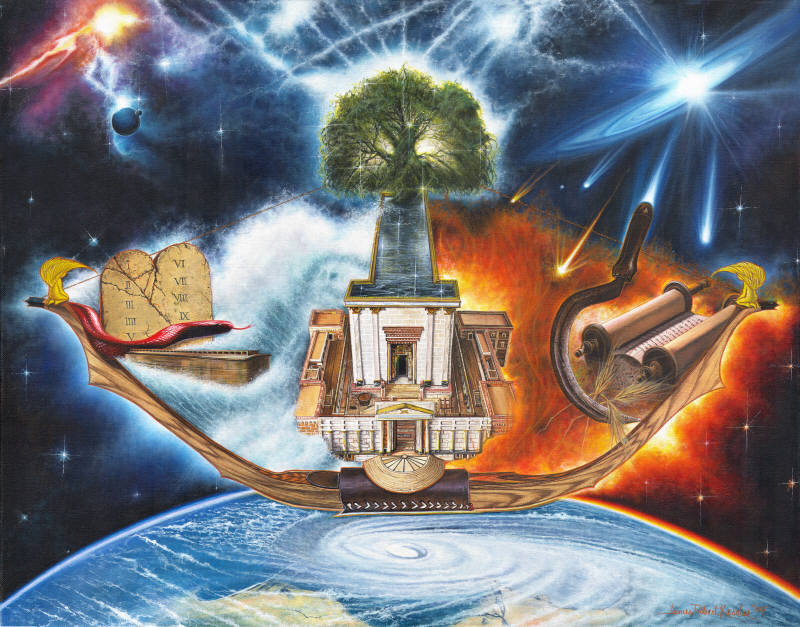| Biblical Creation and Storytelling: Cosmogony, Combat and Covenant
by Brian Godawa
[ABSTRACT: The literary conventions employed in Genesis chapter 1 mark it out, not as a scientific document describing material origins, but as a literary polemic against surrounding ancient Near Eastern pagan religions. This interpretation divests the text from any obligation to communicate “accurate science” to the modern reader. Genesis 1 is a theological-political document that has nothing to do with science as the modern reader understands it. Creation language here and elsewhere in Scripture is not about establishing scientific origins of material substance and structure but about covenantal establishment and worldview.]
"... The creation of the covenant is the creation of the heavens and the earth. The covenant is a cosmos – not a material one centered in astronomical location and abstract impersonal forces as modern worldview demands, but a theological one, centered in the sacred space of land, temple, and cult as ancient Near Eastern worldview demands..."
"This “covenant as creation” word picture is reiterated in a negative way when God judges nations and cultures. If creation of covenant involved establishing the foundations of the heavens and the earth, then covenantal judgment involves “decreation” imagery of the destruction or “shaking” of heavens and earth. Haggai conveys this decreation polemic against the nations, “Then the word of the Lord came a second time to Haggai… saying, “Speak to Zerubbabel governor of Judah, saying, ‘I am going to shake the heavens and the earth.’ I will overthrow the thrones of kingdoms and destroy the power of the kingdoms of the nations” (Hag 2:20-22)."
"The New Covenant kingdom as a 'new heavens and earth' is picked up in the New Testament with the same language of shaking and removing of the previous heavens and earth: 'Yet once more I will shake not only the earth, but also the heaven.' And this expression, 'Yet once more,' denotes the removing of those things which can be shaken, as of created things, in order that those things which cannot be shaken may remain. Therefore, since we receive a kingdom which cannot be shaken …' (Heb 12:26-28). The replacement of the Old Covenant of Moses with the New Covenant of Christ is here described as God 'shaking' and 'removing' the old heavens and earth. To the ancient Jew, the covenants of God with his people are the very “cosmos” of their existence and meaning. So important covenantal events are described in cosmic terms, and the purpose of creation language is theological not natural or 'scientific.'
The inauguration of the New Covenant through the incarnation of Christ is reaffirmed in Revelation as a new heaven and earth cosmos coming out of heaven to eliminate chaos (the sea) and bring a new sacred space of holy city and temple fulfilled in Christ: 'Then I saw a new heaven and a new earth; for the first heaven and the first earth passed away, and there is no longer any sea. And I saw the holy city, new Jerusalem, coming down out of heaven from God, made ready as a bride adorned for her husband. And I heard a loud voice from the throne, saying, 'Behold, the tabernacle of God is among men, and He will dwell among them, and they shall be His people, and God Himself will be among them' (Rev. 21:1-3)..."
Whereas the modern scientific mind conceives of 'cosmos' as a physical system of materials and their properties, the ancient Near Eastern mind of the Hebrew conceived of “cosmos” as the covenantal order of God. Everything had its place and purpose in God’s plan for His people in their land. The idea of the earth as a spherical globe and the heavens as a vast expanse of light years was alien to their thinking. As noted expert on biblical apocalyptics, Milton Terry wrote, 'in these opening chapters of Genesis we are not to look for historic narrative, nor contributions to natural science, but to recognize a symbolic apocalypse of God’s relation to the world and to man.'...
One can only conclude that the attempt to find a concordance between Genesis 1 and any kind of scientific theory, be it young-earth or old-earth, 24 hour days or long ages, fiat creation or evolutionary adaptation is an act of interpretive violence against the text that comes from a culturally imposing modern hubris."
Click Here for entire Article
See also The Collapsing Universe of the Bible by Brian Godowa
"Theologians sometimes use 'Old Covenant' to refer to the Mosaic covenant. There is truth to this in that the Mosaic covenant published most fully the distinctive character of the Adamic covenant under curse. Yet, ultimately, the Old Covenant is the covenant of the original garden of Eden. Ultimately there are two covenants, Old and New. There are two Adams, Adam and Jesus. There are two heavens and earth, the first in Adam and the second in Christ."
James B. Jordan, Through New Eyes (1988), p. 311.
back to Related Articles

|






